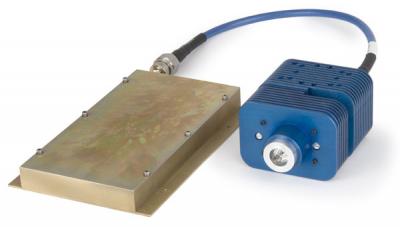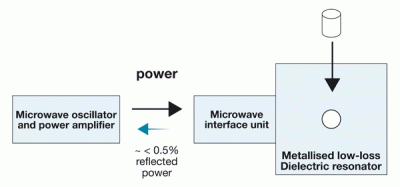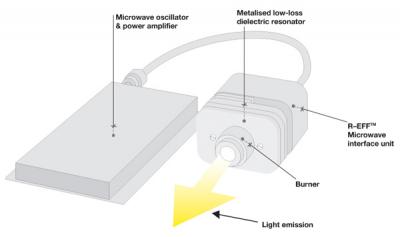Old fashion light bulbs radiate 95% of the energy used to power them as heat and only lasts a couple hundred hours. However a new kind of light bulb from Ceravision promises to revolutionize projector and flat screen TV lighting. Not only will these new lights be cheap, they will last in effect forever. That is they will last longer than the device you put them into. Ceravision tests suggest that the operating lifetimes for the final system may be well in excess of 50,000 hours. Or almost 6 years if you left them on 24/7. With normal use this could mean a decade or more of use. In comparison current projector lights last 1-2000 hours with newer models claiming 4000 hours. (although to be fair some LED lights claim operating lives of over 100,000 hours).
So how does it work?
The device uses microwaves to transform electricity into light. It consists of a small amount of aluminum oxide with a hole in it. When the aluminum oxide is bombarded with microwaves it generates a concentrated electric field in the void. If a cylindrical capsule containing a suitable gas is inserted into the hole, the atoms of the gas become ionized. As electrons accelerate in the electric field they get very very hot, creating a glowing plasma. The light produced by this plasma is very bright, and the process is energy efficient. Traditional light bulbs emit just 5% of their power as light, and fluorescent tubes about 15%, the Ceravision lamp has an efficiency greater than 50%.
The scientists who developed it think it will last for thousands of hours of use potentially decades of operation. Because the light emits from a single point it can be use in projectors and flat screen televisions. It has a small size like an LED but can produce much brighter light.
| Features | Benefits |
| Burner contains no mercury in its fill | 1) This results in an environmentally friendly system that is fully compliant with European RoHS legislation. 2) The burner has no limitation on restart times. It can be turned off and turned on again with no delay. |
| Burner contains no electrodes | No luminance or colour degradation of the emission due to interaction of the burner chemistry with the electrodes. Manufacture of the burner is simple and very low cost. |
| Burner contains low pressure gas fill | Burner remains intrinsically safe even when subject to catastrophic failure. No explosion risk to users. |
| Burner chemistry can be tuned to give primarily molecular excitation or atomic excitation | More uniform spectral content that better matches a black body radiator. |
| Emission can be tuned by modifying burner chemistry | Varying the chemistry of the metal halide salt mix allows the spectral emission to be tuned to the needs of specific applications. This includes various colour temperature variants of “white light”, “UV light” or exclusively “IR light”. |
| Burner is mounted in a metalised low-loss dielectric resonator | Use of a metalised low-loss dielectric resonator allows the microwave component dimensions to be condensed compared to air-based cavities. |
| Microwave interface unit supplying power to antenna in a metalised low-loss dielectric resonator block limits reflected power to <0.5% of incident power | The simple microwave interface unit offers a low cost solution for protecting the power amplifier at burner ignition. Circuitry is reduced to a minimum, and no feedback system is required to modify the amplifier operating frequency. |
| Amplifier can be designed using solid state or magnetron power sources | Allows designers to choose a solution that meets the technical and commercial needs of individual applications. |
(via)
So what does this all mean?
It means that this and other inventions over the next couple years are going to make producing light a highly efficient, environmentally friendly, low waste activity. If the trend continues we should see home lighting reaching a point when they can easily be powered by small solar arrays on the roof of each home. Lets hope all appliances start to become as efficient.



The mercury in flourescent lights is bad. I was reading a warning by the EPA on how to clean up a small mercury spill for a light and this what they had to say:
A. “Never use a vacuum cleaner to clean up mercury. The vacuum will put mercury into the air and increase exposure. The vacuum appliance will be contaminated and have to be disposed of in a hazard waste disposal site.”
B. “Never use a broom to clean up mercury…”
C. “Never wash mercury contaminated items in a washing machine. Mercury may contaminate the machine and/or pollute sewage.”
D. Everyone should be removed from the area where the spill occurred; this includes pets. The impacted areas should be sealed off from other areas and all ventilation systems should be turned off from the impacted area.
E. “Never walk around as your shoes might be contaminated with mercury. Contaminated clothing can spread mercury around.” In case of fire the entire area will be contaminated with mercury and should be sealed off from any type of use.
F. If a spill occurs on carpet, curtains, upholstery or other like surfaces, these contaminated items should be thrown away in accordance…” and with assistance of your local hazard waste disposal site.
What’s up with this, you don’t see a warning on the light bulb packaging for this.
This sounds like a great light source for focused lighting. Wish the technology could be used for general lighting so we could save more energy